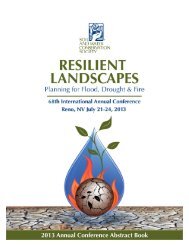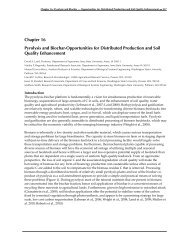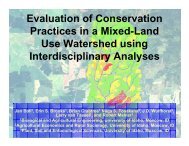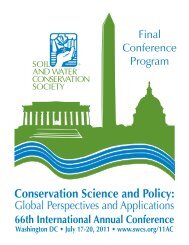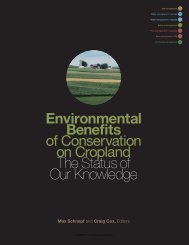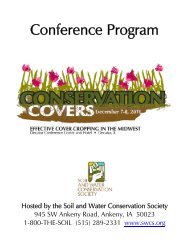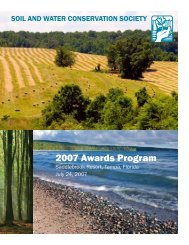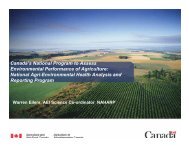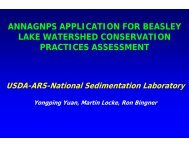Jolley, Leonard - Soil and Water Conservation Society
Jolley, Leonard - Soil and Water Conservation Society
Jolley, Leonard - Soil and Water Conservation Society
You also want an ePaper? Increase the reach of your titles
YUMPU automatically turns print PDFs into web optimized ePapers that Google loves.
<strong>Conservation</strong> Effects<br />
Assessment Project<br />
on Grazing L<strong>and</strong>s: An NRCS<br />
Vision<br />
<strong>Leonard</strong> <strong>Jolley</strong><br />
Rangel<strong>and</strong> <strong>and</strong> Pasturel<strong>and</strong> Ecologist<br />
Resources Inventory <strong>and</strong> Assessment Division<br />
Beltsville, MD
There are 588 million acres of non-Federal<br />
grazing l<strong>and</strong>s in the United States that need<br />
to be managed for:<br />
• <strong>Water</strong> for domestic, municipal,<br />
industrial, <strong>and</strong> commercial<br />
uses<br />
• Food <strong>and</strong> fiber products<br />
• Flood protection<br />
• Waste assimilation<br />
• Scenery<br />
• Recreation<br />
• Wood products<br />
• Minerals<br />
• Wildlife habitat<br />
• Ecological continuity
Complexity<br />
• Profound differences in climate, soils,<br />
plant communities, human interactions<br />
• Basic division between Rangel<strong>and</strong> <strong>and</strong><br />
Pasturel<strong>and</strong><br />
• Plus lots of grazable woodl<strong>and</strong>
TOUR OF U.S. RANGELANDS<br />
Shrub bunchgrass -Colorado plateau
TOUR OF U.S. RANGELANDS<br />
Sagebrush
TOUR OF U.S. RANGELANDS<br />
meadows
Deseret ranch -<br />
Utah
TOUR OF U.S. RANGELANDS<br />
Mountain meadows among the aspen
TOUR OF U.S. RANGELANDS<br />
New Mexico
Upper Sonoran grassl<strong>and</strong>
TOUR OF U.S. RANGELANDS<br />
South Dakota
TOUR OF U.S. RANGELANDS<br />
Florida
TOUR OF U.S. RANGELANDS<br />
Texas
Mojave desert
Coastal grassl<strong>and</strong>s
TOUR OF U.S. RANGELANDS<br />
Introduced bunchgrass
TOUR OF U.S. PASTURELANDS<br />
Pine grassl<strong>and</strong>s
Penn state pastures
What about conservation effects?<br />
Effects for which practices?<br />
• Prescribed Grazing (528)<br />
• Prescribed Burning (338)<br />
• Brush Management (314)<br />
• To start with…
Prescribed Grazing<br />
Managing the<br />
controlled<br />
harvest of<br />
vegetation with<br />
grazing animals.
PURPOSES<br />
Prescribed Grazing<br />
This practice may be applied as part of a<br />
conservation management system to accomplish<br />
one or more of the following purposes.<br />
• Improve or maintain the health <strong>and</strong> vigor of plant<br />
communities.<br />
• Improve or maintain quantity <strong>and</strong> quality of forage<br />
for livestock health <strong>and</strong> productivity.
Prescribed Grazing - continued<br />
• Improve or maintain water quality <strong>and</strong> quantity.<br />
• Reduce accelerated soil erosion, <strong>and</strong> maintain or<br />
improve soil condition.<br />
• Improve or maintain the quantity <strong>and</strong> quality of<br />
food <strong>and</strong>/or cover available for wildlife.<br />
• Promote economic stability through grazing l<strong>and</strong><br />
sustainability.
Elements of Prescribed Grazing<br />
• Avoid adverse affects to<br />
endangered, threatened, <strong>and</strong><br />
c<strong>and</strong>idate species <strong>and</strong> their<br />
habitats.<br />
• Prepare a prescribed grazing<br />
plan<br />
• Guidelines for developing a<br />
prescribed grazing plan<br />
include:<br />
• 1. Goals <strong>and</strong> Objectives clearly<br />
stated.<br />
• 2. Resource Inventory<br />
• 3. Forage Inventory<br />
• 4. Forage-Animal Balance<br />
developed<br />
• 5. Grazing Plan developed for<br />
livestock that identifies periods<br />
of grazing, rest…<br />
• Identify target grazing<br />
pressure to achieve a balance<br />
of lower ecological stable<br />
states <strong>and</strong> higher ecological<br />
stable states for wildlife plants<br />
<strong>and</strong> animals of concern.<br />
• 6. Contingency plan developed<br />
that details potential problems<br />
(i.e., severe drought, flooding)<br />
• 7. Monitoring plan developed
Applying controlled fire to a<br />
predetermined area.<br />
Prescribed Burning
Prescribed Burning-purpose<br />
• PURPOSES<br />
• To control undesirable vegetation.<br />
• To prepare sites for harvesting, planting<br />
or seeding.<br />
• To control plant disease.<br />
• To reduce wildfire hazards.<br />
• To improve wildlife habitat.
Prescribed Burning-continued<br />
• To improve plant production quantity<br />
<strong>and</strong>/or quality.<br />
• To remove slash <strong>and</strong> debris.<br />
• To enhance seed <strong>and</strong> seedling<br />
production.<br />
• To facilitate distribution of grazing <strong>and</strong><br />
browsing animals.<br />
• To restore <strong>and</strong> maintain ecological sites.
NEEDED PRACTICES<br />
Brush Management - 314<br />
Removal, reduction, or<br />
manipulation of nonherbaceous<br />
plants.
Brush management-purpose<br />
• Restore natural plant community balance.<br />
• Create the desired plant community.<br />
• Restore desired vegetative cover to<br />
protect soils, control erosion, reduce<br />
sediment, improve water quality <strong>and</strong><br />
quantity, <strong>and</strong> enhance stream flow.
Brush management-continued<br />
• Maintain or enhance wildlife habitat<br />
including that associated with threatened<br />
<strong>and</strong> endangered species.<br />
• Improve forage accessibility, quality <strong>and</strong><br />
quantity for livestock.<br />
• Protect life <strong>and</strong> property from wildfire<br />
hazards.
Effects on which resources?<br />
• <strong>Soil</strong> – erosion, soil quality, carbon…<br />
• <strong>Water</strong> – quality, quantity<br />
• Air - quality<br />
• Plants – community response<br />
• Animals – wildlife interactions<br />
• And Humans – socioeconomic effects
CEAP Components<br />
• National Assessment<br />
• <strong>Water</strong>shed Assessment
National Assessment<br />
•National, National, regional reporting<br />
•Developing methods <strong>and</strong> databases<br />
•Will Will make use of National Resource<br />
Inventory (NRI)
<strong>Conservation</strong> Treatment Unit Determinations<br />
. <strong>Conservation</strong> practices<br />
. Resource concerns .<br />
Transect 2, 150 ft<br />
PSU point, GPS located<br />
Macroplot measurements<br />
. Rangel<strong>and</strong> Health assessment<br />
. Noxious <strong>and</strong> invasive weeds<br />
. Disturbance indicators<br />
.<br />
Transect measurements<br />
. Plant productivity<br />
. Plant canopy <strong>and</strong> groundcover<br />
. Canopy <strong>and</strong> basal gap<br />
. <strong>Soil</strong> aggregate stability test<br />
. Cover pole <strong>and</strong> height measurements<br />
. <strong>Soil</strong> <strong>and</strong> Ecological site identification<br />
. Site characteristics<br />
Transect 1, 150 ft
Rangel<strong>and</strong> NRI data collection protocol<br />
Sample Plot (0.41 acres)<br />
1=North Quadrant<br />
I = N Quadrant<br />
NE-SW Transect (1) 150 ft<br />
45 o Skew from mag. N<br />
Field protocols<br />
PSU Point<br />
2=West<br />
Quadrant<br />
Rangel<strong>and</strong> Health<br />
Productivity<br />
Rangel<strong>and</strong> Trend<br />
Noxious <strong>and</strong> Invasive Weeds<br />
Plant Canopy <strong>and</strong> Ground Cover<br />
Cover Pole Measurements<br />
Canopy/Basal Gap Measurements<br />
Identify Disturbances<br />
Identify <strong>Conservation</strong> Practices<br />
<strong>Soil</strong> Stability Test<br />
Photographs<br />
III =S Quadrant<br />
3=South Quadrant<br />
4=East Quadrant<br />
NW-SE Transect (2) 150 ft<br />
315 o Skew from mag. N<br />
The transects are oriented 45 degrees<br />
in both directions from magnetic north.
Model<br />
• The Rangel<strong>and</strong> Hydrology <strong>and</strong> Erosion<br />
Model (RHEM) will be used to calculate<br />
water <strong>and</strong> sediment yield.<br />
• Tucson <strong>and</strong> Boise ARS locations will play<br />
an important role.
CEAP Components<br />
• National Assessment<br />
• <strong>Water</strong>shed Assessment
<strong>Water</strong>shed Assessment<br />
• Research at watershed scale<br />
• Improve national/regional models &<br />
approaches<br />
• Determine optimal<br />
placement of practices
ARS Benchmark<br />
<strong>Water</strong>sheds<br />
• 12 long-term research sites<br />
• Variety of cropl<strong>and</strong> conservation practices<br />
• Little range or pasture<br />
• <strong>Water</strong> quality modeling
Reynolds<br />
Creek?<br />
Walnut Creek?
Just one example of the potential<br />
complexity of assessing<br />
conservation effects for grazing<br />
l<strong>and</strong>s…
California Natural Diversity<br />
• High natural diversity at several scales<br />
• The variety of geologic substrates,<br />
topography, climatic types, soils,<br />
vegetation, <strong>and</strong> species of plants is<br />
exceptional (Barbour et al, 1993)<br />
• California has examples of eleven of the<br />
world’s s 12 major soil groups
• Over 30% of all California’s s native plants<br />
are found nowhere else in the world.<br />
• California has the greatest number of<br />
plant species, greatest number of climatic<br />
zones, most complex geology, greatest<br />
number of endangered species, <strong>and</strong><br />
finally, the most diverse <strong>and</strong> complicated<br />
patterning of vegetation of any area of<br />
comparable size in North America (Sawyer<br />
et al 1995[CNPS])<br />
• A half-dozen major North American<br />
biomes squeeze together, causing 1,000<br />
distinctive plant communities (Barbour et<br />
al 1993)
• More than 1000 alien plant species have<br />
been introduced to California in the last 200<br />
years, replacing the 34 native plants gone<br />
extinct <strong>and</strong> the 857 plants now rare <strong>and</strong><br />
endangered.<br />
• In 1769 Father Junipero Serra established<br />
San Diego settlement - brought at least<br />
three exotic weeds with him. By 1824 at<br />
least 16 exotic species had become<br />
established. During the Mexican occupation<br />
of 1825-1848 1848 an additional 63 species were<br />
added. Pioneer American settlements of<br />
1849-1860 1860 brought 55 more.
Complexity of Grazing<br />
• Livestock <strong>and</strong> wildlife managers,<br />
especially in California, are faced with<br />
an exceedingly complex environment<br />
• <strong>Soil</strong>s are highly variable across the<br />
rangel<strong>and</strong> l<strong>and</strong>scape by depth, texture,<br />
chemistry, organic matter, bulk density,<br />
<strong>and</strong> other parameters.
• Topography <strong>and</strong> terrain are often complex,<br />
confounded by soil <strong>and</strong> microclimate<br />
differences, yielding very ‘patchy’ plant<br />
communities.<br />
• Growth curves of individual plant species<br />
within these ‘patches’ are different,<br />
causing individual plants to reach maturity<br />
at different times <strong>and</strong> to have varying<br />
palatability over these periods.<br />
• California climate is notoriously fickle - the<br />
amount <strong>and</strong> timing of precipitation <strong>and</strong><br />
associated temperature is critical to the<br />
production <strong>and</strong> composition of rangel<strong>and</strong>
• Trying to cope with all these factors is<br />
much more difficult than conventional<br />
agriculture where soil tillage, fertilization,<br />
irrigation, precision seeding, <strong>and</strong><br />
monoculture of plants bred for specific<br />
traits render fewer unknowns <strong>and</strong> less<br />
variability compared to rangel<strong>and</strong>.
ECOLOGICAL SITE<br />
• DEFINITION<br />
• A distinctive kind of l<strong>and</strong> with specific<br />
physical characteristics that differs from<br />
other kinds of l<strong>and</strong> in its ability to produce<br />
a distinctive kind <strong>and</strong> amount of<br />
vegetation.<br />
• They have the potential to be an important<br />
organizing element for conservation effects<br />
on rangel<strong>and</strong>.
Ecological Site Descriptions
Vegetative Zones<br />
Mountain Savannah<br />
Mixed Prairie
Grazing l<strong>and</strong>s CEAP products<br />
• Model results<br />
• Bibliography (National Ag. Library)<br />
• Literature synthesis<br />
• Interim products
Bibliography<br />
• Practice effects, ecological services<br />
• Diverse input, international sources<br />
• 1,300+ citations, 1980 – present<br />
• October 2006 publication
Literature Synthesis<br />
• NRCS-ARS collaboration<br />
• Contract to<br />
<strong>Society</strong> for<br />
Range Management<br />
• Involvement by the American Forage &<br />
Grassl<strong>and</strong> Council
Coordination<br />
• <strong>Society</strong> of Range Management<br />
• American Forage<br />
& Grassl<strong>and</strong> Council<br />
• National Cattlemen’s<br />
Beef Association<br />
• Ecological <strong>Society</strong> of America
Upcoming CEAP GL Events<br />
• Dec. 5-7, 5<br />
2006 Beltsville, MD<br />
• Organizational meeting for literature<br />
synthesis<br />
• Feb. 14, 2007<br />
Reno, NV<br />
• CEAP Grazing l<strong>and</strong>s convene at the<br />
<strong>Society</strong> for Range Management Annual<br />
meeting
Thanks!<br />
I welcome your comments,<br />
suggestions, participation!<br />
leonard.jolley@wdc.usda.gov



